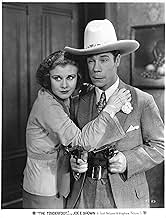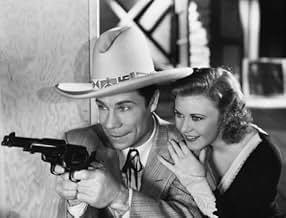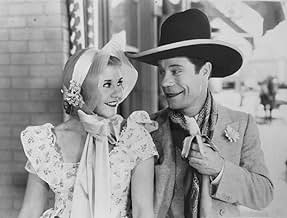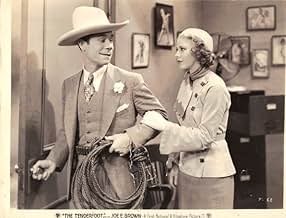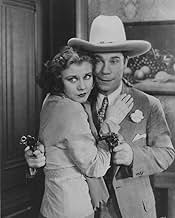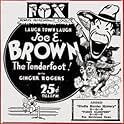Calvin Jones is a cowboy who wants to invest in a Broadway play. Ruth Weston, a secretary, learns that her boss, Joe Lehman, is attempting to swindle Jones and pulls a successful coup d'etat... Read allCalvin Jones is a cowboy who wants to invest in a Broadway play. Ruth Weston, a secretary, learns that her boss, Joe Lehman, is attempting to swindle Jones and pulls a successful coup d'etat producing a play that she stars in.Calvin Jones is a cowboy who wants to invest in a Broadway play. Ruth Weston, a secretary, learns that her boss, Joe Lehman, is attempting to swindle Jones and pulls a successful coup d'etat producing a play that she stars in.
- Kitty
- (as Marion Bryon)
- A Tart at the Depot
- (uncredited)
- The Hebrew
- (uncredited)
- The Chef
- (uncredited)
- Depot Bum
- (uncredited)
- Lefty Duran - Racketeer
- (uncredited)
- Waiter
- (uncredited)
- Cafe Cashier
- (uncredited)
- Dining Customer
- (uncredited)
Featured reviews
Examples include a cowboy, who upon arriving in NYC, spots a group of men in cowboy suits who turn out to be obviously gay chorus boys. Later in the film, he malaprops "ejaculation," instead of "salutations!" Yes, there's plenty of innuendo--much of it sophisticated and/or subtle, but nothing that isn't heard (ahem, recycled) on U.S. network primetime/family television today.
Ginger Rogers appears as Brown's feisty love interest, but don't expect her to sing, dance or wear ostrich feathers. Still, she's charming and more interesting here than in her Oscar-winning role in 1940's "Kitty Foyle."
Joe E. Brown, who is probably best remembered today for his turn as Osgood Fielding III in "Some Like It Hot," plays the cowboy broadly. Still, he's much more palatable than in other frequently seen performances (reference Flute in 1935's "A Midsummer Night's Dream).
In addition to the historical interest, the film is an enjoyable and well produced piece of fluff. The short 70-minute run time seems even shorter to me. Hope you enjoy it!
Comic Joe E. Brown has a wonderful time, striding about Manhattan in a ten-gallon hat & boots, packing a pair of six-shooters and carrying a lasso. No hick he, shysters of both sexes find he's not an easy mark--until he's taken in by a couple of desperate play producers who want to unload 49% of their latest flop. Brown is a constant wide-mouthed delight, whether roping his luggage at Grand Central Terminal, trying to be neighborly to a bunch of chorus boy cowboys, or galloping after a group of taxi-driven gangsters on a busy New York street, he makes this rather naughty Pre-Code comedy boil.
Perky Ginger Rogers scores as a secretary honest enough to want to protect Joe and his money. Lew Cody & Robert Greig ooze false charm as the producers (Greig even looks a little like the great Mostel) and brassy Vivien Oakland stirs things up a bit as the play's spoiled star.
Movie mavens will recognize Herman Bing as an opinionated chef, Nat Pendleton as a jealous husband and Richard Cramer as a gangster, all three uncredited.
The last few seconds of the film, involving some very peculiar triplets, is hilarious.
One problem is that, while the best scene in the whole picture is Brown explaining to a prospective investor, i.e., the latest sucker, the plot of this 'masterpiece', which turns out to be a rural melodrama old hat by 1914 or so, we never actually see it presented on the stage. I guess the budget wouldn't allow for it. An early and hilarious musical number is obviously lifted from some other film which may be a hint as to the constraints under which director Ray Enright was working.
Simple comedies such as this live or die on their performers. Brown is in fine form as the unlikely Texas cowboy come to the city to make his fortune. He's supported nicely by Ray Cody as a sleazy producer looking for funds and by the young Ginger Rogers playing Cody's secretary and Brown's love interest in an unusually fiery role for those functions. Ginger is also the recipient of a couple of the nicest closeups that she would ever receive courtesy of cinematographer Greg Toland no less, famous for his later work on Citizen Kane among other masterpieces. The Tenderfoot is no masterpiece, but it does have its moments.
Did you know
- TriviaThe musical play, "The Tenderfoot," Book and Lyrics by Richard Carle, who also starred in the play, opened in Chicago, Illinois in July 1903. It moved to The New York Theatre in New York City on 22 February 1904 and closed on 30 April 1904 after 81 performances.
- GoofsEarly in the movie, when the Peter Brown character wanders into a Kosher restaurant, the menu shown lists Salami and Cheese at the very bottom, which is definitely not Kosher, as meat and milk items may not be combined into one dish. Then he proceeds to order bacon, which would definitely never be served in a Kosher restaurant.
- Quotes
Calvin Jones: [after seeing some flamboyant chorus boys in cowboy outfits and wearing make-up at a Broadway restuaurant] They may be cowboys; but, they ain't from Texas.
- ConnectionsFeatures Lilies of the Field (1929)
- How long is The Tenderfoot?Powered by Alexa
Details
- Release date
- Country of origin
- Languages
- Also known as
- La novia del gángster
- Filming locations
- Production company
- See more company credits at IMDbPro
- Runtime1 hour 10 minutes
- Color
- Sound mix
- Aspect ratio
- 1.37 : 1

